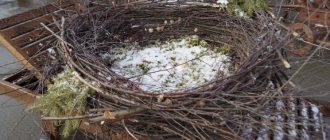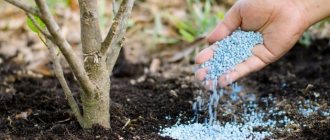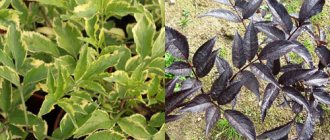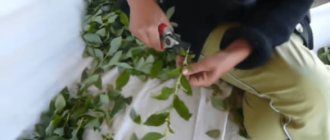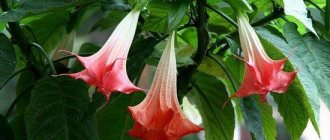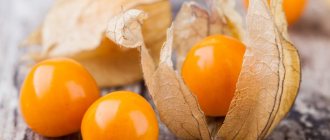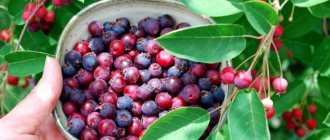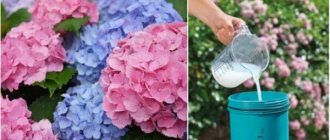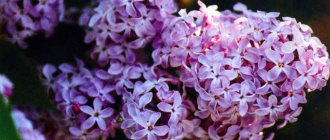Chemical composition of chicken manure
The main element in the chemical composition of chicken manure that interests vegetable growers is nitrogen. It is in the waste of domestic chickens that it is contained the most (up to 1.9%), according to this indicator, chicken droppings are ahead of other types of manure, including droppings from other poultry.
It contains a lot of phosphorus (3 and 2.5 times more than other manures), magnesium, potassium and sulfur, and also contains other trace elements, such as iron and copper. The high concentration of elements makes chicken manure an economical fertilizer, but, on the other hand, dangerous if used incorrectly.
Features of chicken manure as fertilizer
Bird and animal waste has long been considered a good fertilizer due to the nutrients it contains. The application form allows plants to quickly absorb nutrients.
For comparison, mineral fertilizers are washed out of the soil and turn into difficult-to-perceive compounds in just one season, while manure feeds vegetables for 4 years . The bulk of the manure used reaches the top line of effectiveness only in 2-3 years, and chicken manure begins to have a positive effect after 7 days. It contains up to 4% nitrogen, 2.5% phosphorus, 2% potassium, as well as small doses of iron, magnesium, calcium, sulfur, zinc, copper and cobalt.
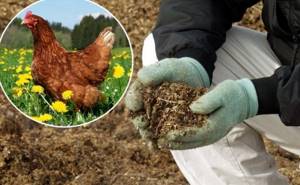
The most convenient form of storage is in dried form. It also ensures that large amounts of nitrogen are retained. Drying is carried out with good air access; it is advisable to add peat to absorb moisture. For long-term storage, humus is placed in plastic barrels or boxes with ventilation holes.
Kinds
There are 3 types of chicken manure: litter-free, litterless and dry. They differ in structure and composition.
Litter droppings have a moisture content of 30-50% and have a loose consistency. Dry peat, shavings, sawdust, and straw are used for bedding. In this form, all nutrients are retained in the litter, since the litter, acting as a preservative, helps to preserve them.
In its pure form, litter-free droppings are a viscous, unpleasant-smelling mass. It contains a higher concentration of nitrogen and other substances, but also contains weed seeds, microorganisms, larvae and eggs of pests and parasites.
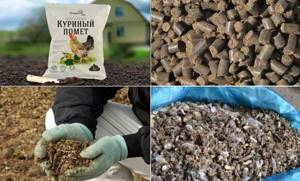
Dry litter with a moisture content of no more than 20% is an organic fertilizer that can be stored in a dry place. It is odorless and can be easily transported.
The litter must be stored correctly: nitrogen loss occurs in the open air, up to half in 2 months. To reduce losses, you need to dry or freeze the raw materials or mix them with sawdust, straw, peat (1 to 1), superphosphate (6-10%).
It can also be composted with peat and straw, plant debris, grass, and garden tops. It cannot be stored outdoors, it dries out, nitrogen loss occurs, and its value for vegetable crops quickly decreases.
How to collect chicken manure for fertilizer
It is recommended to keep chickens, especially in winter, on thick bedding, which is straw, hay and sawdust. In this case, in the spring you can carry out a thorough cleaning of the chicken coop and completely remove the accumulated waste. A large amount of work involves the use of forks, shovels, rakes, storage containers and a garden wheelbarrow.
If chickens are kept without bedding, then the litter will have to be removed every day. An alternative option is to rake them into piles and, after accumulating a sufficient volume, put them away in another place.
While working, be sure to wear a respirator and rubber gloves. Precautionary measures are necessary due to the danger of infection with worms. In the droppings layer, the process of rotting occurs, which means fungal and bacterial infections develop, often pathogenic. At the end of the collection process, it is necessary to disinfect the tools and wash the clothes.
If there is a need for long-term storage of the resulting material, it is placed in compost . For immediate use, an infusion is prepared or embedded in the ground.
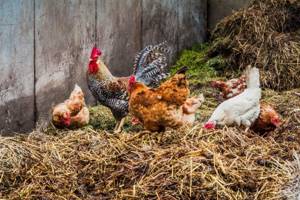
At large enterprises that produce granular litter, waste collection is automated - it is immediately sent for drying, after which it is ground. This processing allows the loss of organic and mineral components to be minimized. Granular fertilizer is as effective as one collected from your own plot .
How to make fertilizer from chicken manure
It should be remembered that the concentration of organic matter in it is incredibly high, therefore, in order to avoid errors with dosage, fertilizer is often used in the form of tinctures. If the droppings are collected with bedding, then this is an ideal way to enrich the compost.
There are many methods for creating fertilizer from chicken manure, but the most commonly used are infusion and compost. The first is used in the summer, during the active growing season. The second is used for recycling and storing large amounts of waste that is generated after spring cleaning of the chicken coop. This option requires the presence of litter, the decomposition and fermentation of which takes a certain time.
Advantages of use
Chicken manure contains all the elements necessary for plants, and in the required volume and combination. In the soil, organic matter is transformed into a form that is easily accessible to plants, and as a result of the activity of microorganisms that process it, the content of nutrients only increases.
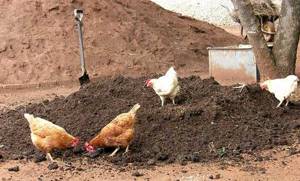
In terms of its effect on plants, manure can be compared with the best mineral fertilizers, but, unlike them, nitrogen and phosphorus are in accessible form, do not form harmful compounds, and are better absorbed. The effect of the litter helps to increase productivity within 2-3 years.
The advantages of using chicken manure as fertilizer are as follows:
- rapid growth of young plants, green parts of trees and bushes;
- friendly flowering and fruit set;
- acceleration of their maturation;
- increasing drought resistance;
- increase in yield up to 40%;
- strengthening the immune system, increasing resistance to bacteria and fungi;
- alkalization of acidic soil, increasing its humus content.
This fertilizer is convenient to use, since it contains not only the main elements, but also microelements that are no less important for the plant, which is why there is no need to apply them separately. It does not poison the soil in the garden, does not accumulate in it, does not contribute to the formation of nitrates in fruits, and does not pose a danger to humans, animals, or insects.
As you can see, chicken droppings have many advantages that make it an excellent fertilizer. Those who keep poultry in their backyard always have it in stock, so it is completely free. Other gardeners need to buy it, but the cost is quite affordable.
We recommend reading
Instructions for use of growth stimulator Epin extra for plants
Instructions for using succinic acid, preparing the solution
How to prepare a solution of boric acid and spray plants
Instructions for using copper sulfate in gardening
Advantages and disadvantages of use
When figuring out how to use bird droppings, it is important to understand that chicken waste has the greatest effect as a fertilizer. The advantages of using them include:
- Acceleration of vegetable ripening by 1 week in comparison with plantings that were not fed.
- Increase in yield up to 40%.
- Creating immunity of crops to fungal and bacterial diseases - late blight, root rot, scab, etc. The effect is achieved due to the content of copper and iron in the composition.
- Positive effect on acidified soils and crops that are sensitive to acidity. The pH level fluctuates between 6-8 units, which depends on the degree of decomposition. The most alkaline composition will be observed when completely overheated.
- Increased growth, abundant flowering, higher percentage of ovary formation .
- Improving the physical properties of soil.
- Can be used on almost all crops grown in the garden.
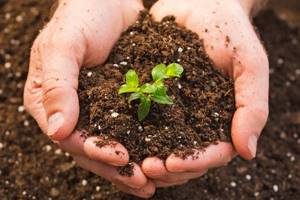
In addition to the positive aspects, we must not forget about some negative ones. This manure is highly saturated with nitrogen in its ammonium form. When fertilizer decomposes, large amounts of ammonia and methane are released, which negatively affect plant health. Chicken manure cannot be used in its pure form , only in the fall after removing crops from the area.
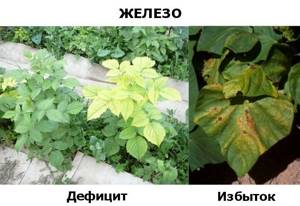
For what crops can it be used?
It is known that not all plants react equally to various fertilizers. As a fertilizer, chicken manure can be used for all types of crops: vegetables, fruit trees, berry bushes, flowers, but especially for greens. In this respect it is universal. It can be applied to a limited extent to plants that prefer acidic soil, but there are not many of them among cultivated plants.

It is recommended to use chicken manure for tomatoes, eggplants, potatoes, and cabbage. They are fed at the root 3 times a season. But it needs to be applied to root crops carefully and only at the beginning of their growing season; if you do this later, when the root crops are actively forming, nitrogen will make them clumsy and tasteless. At this time it is better to add phosphorus and potassium.
It is necessary to feed onions and garlic, lettuce, parsley, and dill in the fall, so that the nitrogen passes into an easily digestible form, and again in the summer, in June. For onions and garlic, manure is added at least a month before the heads are fully formed. Chicken manure is not suitable for blueberries, camellias, azaleas, heathers and rhododendrons.
How to make fertilizing at the dacha with your own hands
It is advisable to learn in advance the nuances of using chicken manure as fertilizer: how to dilute it and what to do with the finished fertilizer. The preparation steps are as follows:
- Soaking raw materials.
- Infusion for a certain period of time.
- Straining (filtration).
- Diluting with water to the desired concentration.
Thanks to soaking, the rotting process is accelerated. Start the process by adding a little water to the litter. The amount of water depends on the initial state of the litter:
- for fresh - from 1 to 2 l;
- for granular and dry - from 2 to 5 l;
- for stale - from 1 to 3 liters.
Fresh excrement is mixed with water in a large container, stirred to break up lumps until they are completely dissolved and the mass becomes homogeneous. The mixture is then left in the sun for 2 to 6 weeks. A signal that the concentrate is ready will be a persistent smell of earth and the absence of bubbles on the surface. The liquid must be filtered if you plan to use it for spraying. The final stage is adding the required volume of water to the concentrate.
To prepare dried chicken manure as a fertilizer, follow the above steps but add a bacterial preparation at the end to start fermentation.
Preparing fertilizers: recipes
For use at home, you can prepare several types of fertilizers based on chicken manure - water infusion and rotted raw materials. There is also fertilizer, in powder and granules, it is produced industrially, it can be purchased by those who do not have the opportunity to use the droppings from their chickens. You can also mix chicken droppings with other types: duck, goose, horse manure, pig, rabbit, cow, etc.
Infusion
This form of fertilizer is most often used for watering and spraying. To feed plants, chicken manure should be diluted in the recommended proportions.
Recipe 1
You can prepare an infusion by first mixing fresh raw materials 1 to 1 with water, leaving to infuse until fermentation is over (up to 2 weeks), which can be determined by the disappearance of foam. For irrigation, dilute 1 liter of this concentrate with 20-25 liters of plain water. This infusion is suitable for watering vegetables, shrubs and trees. To spray on a leaf, dilute the same solution 1 to 30 (1 liter per 3 buckets), strain and pour into a spray bottle. The infusion should be consumed as quickly as possible, since the ammonium nitrogen group quickly evaporates.
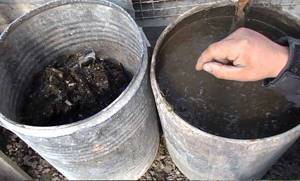
Since there is quite a bit of potassium in chicken fertilizer, to increase its content, when preparing the infusion, you can do this: add 100 g of ash or 15 g of potassium magnesia to a bucket of diluted infusion. Use during fruiting.
Recipe 2
The easiest way is to dilute dry raw materials in warm water 1 to 15-20. Use immediately, pouring 1 liter under the plant.
Indoor flowers can also be fed with an infusion of chicken manure. In this case, the concentration will be much lower: 1 to 100, that is, 100 g of raw material will be needed per bucket of water. It is not necessary to infuse this liquid; it is enough to dissolve the droppings well in water and water the flowers with fresh liquid. The fertilizer is suitable for petunias, annuals, and indoor flowers.
Humus
Processing chicken manure in a compost heap makes it suitable for all crops, including those that do not tolerate fresh. Making good compost from chicken manure:
- Pour the raw materials into a layer of 0.2 m at the bottom of the pit (you can add other manure).
- Place a 0.3 m mixture of peat, sawdust and straw on top.
- Then again a layer of droppings and mixture. The height of the entire pile should not exceed 1 m.
- Cover it with film to maintain temperature and humidity.
After rotting for at least 6 months, the compost is ready and can be applied to the plants.
Granular litter
In your home, there are usually no problems with fresh chicken droppings, since many people keep chickens. For those gardeners who do not have them, you can buy powdered or granular manure.
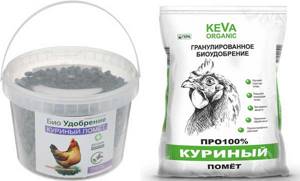
The advantages of using chicken manure in granules: it is well stored and always accessible, it takes up little volume, it has no odor, during processing, all pathogens, parasite eggs, and weed seeds are destroyed, but nitrogen and valuable microelements are preserved.
According to the instructions for using granulated chicken manure, you can apply it in its pure form - into the ground, but you must remember that the contact of the granules with the roots is dangerous, so it is necessary to scatter them not under the bushes, but in the spaces between the rows. The norm for vegetables is 100-150 g per 1 sq. m, for bushes and trees - 100-300 g.
You can also prepare liquid fertilizer from granulated chicken manure: take 1 part to 50 parts water, leave for 1 day. For seedlings, use in a ratio of 1 to 100. Pour 0.5 liters of this infusion of chicken manure under the root of the seedlings. Frequency of application – 3 times per season.
Methods of using chicken manure
Conventionally, there are three ways to store chicken manure: granulation, composting and in liquid form. In addition, sometimes these methods are combined: granular litter is soaked or mixed with compost. You can not complicate life at all and scatter droppings around the garden before plowing, but then you won’t be able to create individual conditions for different plants.
Litter granulation
The method is ideal for storing litter in small areas, as well as for subsequent sale (demand is stable from year to year). After such processing, the fertilizer loses its specific unpleasant odor, but the nutritional value remains unchanged.
It’s easy to prepare the granules:
- Polyethylene film is spread on shelves or any elevated surface.
- Spread the droppings in a thin layer.
- Dry in the sun for 2-3 weeks, stirring occasionally.
- Mix with peat or humus in a 2:1 ratio.
- Packed and put away for storage.
Ideal for storing granular litter are wooden boxes with holes 0.5-1 cm in diameter. If they are not available, you can pack the mass in sugar bags and store it on pallets in a place protected from precipitation.
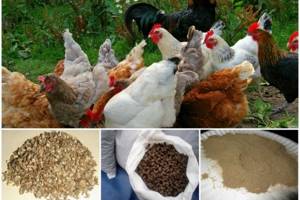
Granular fertilizer is used for application to beds in dry form and for making mash.
Liquid storage
If there are few chickens and the droppings are to be used for a short time, it is advisable to prepare liquid fertilizer. To do this, you will need large-capacity containers - barrels, bathtubs, large pots, etc. It will be good if they are closed with a lid of a suitable size.
Prepare liquid fertilizer according to the following recipe:
- Pour the droppings with warm water in a 1:1 ratio.
- The mixture is thoroughly mixed to obtain a mass of homogeneous consistency.
- The resulting composition is loaded into a container, closed with a lid and kept in the sun for 7 days.
- At the end of the period, the mass is mixed again.
- The resulting concentrate is stored in a shady place.
Liquid chicken manure is stored for no more than two months, then its value as a fertilizer decreases sharply.
To feed plants, 1 part of the concentrate is diluted with 30 parts of water; for application under shrubs and fruit-bearing trees, proportions of 1:20 or 1:15 are used. The resulting solution is used to water the grooves dug along the projection of the crown.
During the preparation of the liquid concentrate, gases with an unpleasant odor are released, so it is better to take the container to the end of the area.
Making compost
If there is a lot of droppings or if they are mixed with the litter, you can make excellent compost. To do this, dig a hole, the length and width of which are arbitrary, and the depth is 1.5 m. The place for it is chosen on a hill. Lay litter from the chicken coop in the hole, mixing it layer by layer with soil, peat or humus. Cover everything with dark film and leave for a year. Then the fertilizer can be used to improve the structure of the soil when preparing beds or prepare liquid mash based on it.
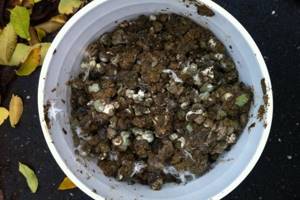
Another option is to prepare a mulching composition. To do this, the droppings are not removed from the chicken coop, adding fresh grass, straw, and sawdust until the layer thickness reaches half a meter. Now the room is cleaned, the resulting mass is placed in compost pits, where it ripens, acquiring a uniform consistency.
Prepared compost can be used to mulch vegetable beds, berry fields and garden trees.
How and when to use for different crops
It is permissible to use the litter in its pure form - fresh or rotted, or to prepare solutions and infusions from it. Fresh is applied to those crops for which the growth of green mass is important or to those that produce green products. It does not spread in large quantities, it dries quickly. It is undesirable to take chicken droppings from poultry farms; there is a lot of fresh sawdust, which, when rotting, absorbs nitrogen and takes it away from the plants.
But mostly, for example, for vegetables, rotted droppings are used or liquid fertilizers are prepared. It contains less nitrogen, it does not accelerate the growth of green mass, but it perfectly nourishes the plants.
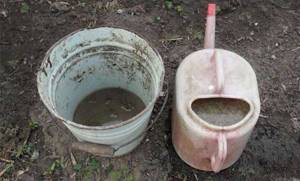
Both fresh and rotted droppings can be applied under trees and berry bushes. The easiest way is to spread dry chicken manure evenly in a circle near the trunk in the fall or early spring and leave it to naturally dissolve or mix it with the soil while digging it. This feeding is done once a year. For flowers, it is better to take rotted chicken manure; it must be mixed with other organic matter. Apply in small dosage.
Recommendations for fertilizing with chicken manure infusion:
- For cucumbers - 3 times (when real leaves, flowers appear and during fruiting). Dry manure can be added to the holes, 10 g per hole, when planting.
- Feed roses starting from the 2nd year of life. The solution is 1 to 20, the norm is 0.5 l per 10 l. During the season, you need to feed rose bushes with chicken droppings 3 times: before and during flowering, the last time at the end of summer. When planting flowers, add 100-200 g of dry raw materials into the hole.
- To feed tomatoes with chicken manure, only 1 liter per plant is enough. Number of applications – 3 times per season. At the same time, you need to dilute chicken manure for feeding tomatoes no more than 1 to 15. When planting, add 10 g of dry raw materials into the holes. You can feed peppers and eggplants in the same way.
- Onions should be fertilized with chicken manure before the turnips begin to form; when planting, 100 g of dry manure can be distributed over 1 square meter. m. beds. The same applies to using chicken manure for garlic.
- To feed grapes with chicken droppings, you need 4-6 buckets of infusion for an adult bush. At the same time, you need to add potassium (wood ash).
- To feed apple trees and other trees in spring, you can use 1 bucket of infusion per plant or 0.5 kg of dry manure.
- Feed the cabbage when planting - 0.5 kg of dry raw materials per 1 sq. m. Then you need to fertilize the cabbage 2-3 more times per season, but with infusion, 1 liter per root.
- Feeding carrots and beets when planting - 150 g of dry raw materials per 1 sq. m.
- For potatoes - 0.5-0.7 kg during soil preparation.
- For strawberries - before flowering, 1 liter of solution in a concentration of 1 to 20.
You need to remember that droppings in contact with roots or leaves can burn them, so before fertilizing you need to water the plants with plain water.
Ways to use chicken manure
Gardeners and vegetable gardeners use different methods of feeding plants with chicken droppings. The simplest is the express method. Take a pinch of droppings, maybe fresh, and mix it with water to make a creamy mass. It is dissolved in a bucket of water, the solution is poured into a watering can and the beds are watered. This method is good when you urgently need to feed plants in a small area.
Another method will take more time - three days, but is suitable for processing large areas. You will need an iron barrel or pan. Fertilizer recipe:
- Add litter to one third of the volume.
- Pour water almost to the edge.
- Add a squeeze or two of yeast.
The container is covered with a lid, exposed to the sun and aged for three days. Now you can mix the mixture, dilute it with plenty of water and water the plants.
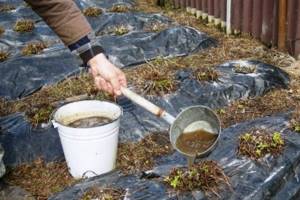
You can strengthen the composition by adding a glass of ash to 10 liters of chicken solution.
Feeding plants with chicken manure is different; both the method of application and the dosage change. The table shows the crops that need this fertilizer the most.
| Culture | Preparation of fertilizer | Method of application |
| Fruit trees | 0.5 kg/10 l water | Watering along the border of the tree trunk circle |
| Currants, raspberries | 1 liter of concentrate per 10 liters of water | Watering between rows. You can mulch with chicken coop litter. |
| Grape | Compost is used | Application into furrows dug at a distance of 0.5 m from the plant. |
| Pumpkins and tomatoes | 0.5 kg/10 l water | Watering at the rate of 5 l/m2 |
| Cabbage | 1 liter of solution per plant | |
| Roots | Watering at the rate of 4 l/m2 | |
| Potato | Liter of liquid concentrate per 15 liters of water | 1 liter per plant |
| Strawberry | Liter of liquid concentrate per 20 liters of water* | 1 liter per plant |
*The same composition can be successfully used for watering flowers.
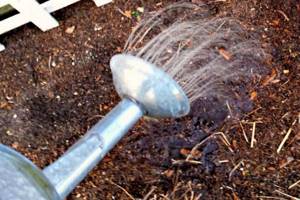
You can also feed roses with chicken droppings, but only if they are more than a year old and the rose garden has been previously watered. For fertilizer use a 5% solution of chicken manure. Water roses three times: before flowering, during it and at the end of summer. For the winter, the rose garden can be mulched with a mixture of manure and sawdust/straw.
General rules for using manure for fertilizer:
- You can't water it at the roots.
- Fertilize only after watering with regular water.
- It is advisable to feed plants at night rather than in the morning. It is prohibited to carry out this work during the day.
- You can apply chicken manure no more than four times per season.
- There is no need to apply fertilizer to coniferous plants.
If the soil on the site is heavy and poor, you can apply chicken manure in the fall for plowing or digging. The consumption in this case is 1 kg/m2. Over the winter, complex chemical compounds will break down into substances that can be absorbed by the plant. In spring, manure can be applied to light soils of average fertility.
It is important to avoid overdose, which may not only reduce yields, but also accumulate nitrates harmful to humans in fruits and berries.
How is chicken manure useful for fertilizing your garden?
Chicken manure has a unique composition, making it very useful as a fertilizer:
- it contains 62% organic matter, nitrogen, phosphorus, potassium, calcium and many other trace elements;
- there are fewer harmful microorganisms in chicken droppings than in manure;
- in terms of nitrogen and phosphorus content it is not inferior to mineral fertilizers and mineral complexes;
- chicken droppings enrich the soil with minerals that remain in it for a very long time;
- when applying fertilizer, the yield increases by 2 times;
- improves plant resistance to root rot and scab;
- organic matter makes the soil pH neutral;
- thanks to the application of fertilizer, fruits are better set and formed;
- they ripen faster.
Useful material:
Articles about organic fertilizers
Mineral fertilizers at the dacha
Green manure
When should you not use this fertilizer?

Natural origin and effectiveness of application do not make the litter 100% beneficial for all plantings. Fertilizer is not used during harvesting, as this will negatively affect the taste and smell of the product. You should not take excrement from free-range chickens: it may contain parasites and pathogenic microorganisms. It is not recommended to fertilize bulbous crops (onions, garlic) and salad greens with manure.
What can it be used for?
Despite all the usefulness of organic matter, it is necessary to clearly understand how to fertilize a garden with chicken manure and in what dosages to use it. Not every plant will grow better with such fertilizing. For example, some types of vegetables can change their taste characteristics. A small amount of chicken manure can make beets sweeter, but if you overdo it, the root crop will become dense and stringy.
The best food to feed from chicken manure is nightshade plants: bell peppers, eggplants and others. It is recommended to fertilize them with organic matter at the beginning of the growing season, in the spring. You cannot feed the plants after the ovary has formed, otherwise the fruits will take a long time to ripen. Melons, cucumbers and cabbage are excellent organic crops. You can significantly improve the taste of strawberries if you feed them with chicken manure constantly.
Fruit trees and shrubs need feeding 2 times throughout the entire season. If you put fertilizer in the holes when planting plants, you can provide them with useful substances for at least two years.
Onions and garlic must be fertilized before the growing season. If you do this later, the above-ground part will grow, but the root crop will not gain mass.
For which garden plants is this feeding option suitable?
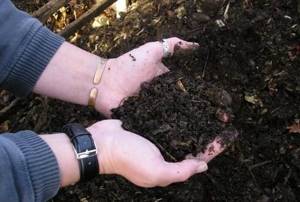
The rules for using chicken manure as fertilizer differ for different crops.
- Cucumbers. The bushes are shed with infusion, avoiding direct contact to avoid burns. Therefore, the infusion is poured between the rows, without getting on the roots, lashes and leaves.
- Tomatoes. They are fed at the beginning of the growing season at the rate of 60 kg of litter per 10 m2 of beds. It is more economical to use a watering solution - you will need 5 buckets for the same area.
- Strawberry. You can’t apply droppings directly under the bushes, but when preparing the beds, fertilizer will bring undeniable benefits.
- Raspberries. The bushes are fed in the spring to gain green mass. The method of application is by digging.
- Cabbage. It responds best to mulch prepared with poultry litter. Scatter over the beds in a ratio of 3 kg per 1 m2.
- Potato. The droppings are used only in the fall before digging.
- Flowerbeds. Chicken manure is used for flowers 3 times. The first time is in March, the second time is when the ovaries form, the third time is after the flowers fall off.
Plant nutrition
Tomatoes
A one-time application of kuryak helps to increase the yield and size of tomatoes. Rotten droppings are laid out around the holes in the spring. Raw material consumption is about 4 kg per square meter. You can also feed the bushes during the growing season. They make a liquid solution, the consumption is a couple of liters per bush. If the stems of the seedlings begin to water, stop watering.

Feeding cucumbers
Feeding with chicken droppings helps get rid of barren flowers. The seedlings are watered until the first flowers appear. When irrigating cucumbers, you need to make sure that the solution does not get on the roots. Before watering, it is recommended to leave the working solution in air for several hours to release the uric acid. As soon as they bloom, stop feeding the cucumbers.
Potato
How to fertilize potatoes with chicken manure? Kuryak does not directly affect the size of tubers and yield, however, it increases leaf photosynthesis. Thanks to strong stems and leaves, the fertility of the bushes also increases. Also, droppings increase the potato's resistance to diseases and mold.
Fertilizer is applied before autumn digging, adding potassium - for 10 measures of humus, take one measure of potassium agrochemical. The fertilizer is mixed and evenly scattered over the area (50 kg per hundred square meters). When the tops have grown by 15-18 cm, irrigate with a solution - once a season. After the buds form, gardeners recommend feeding the potatoes with wood ash, which is sprinkled on the ground around the bushes.
Strawberry
Garden strawberry bushes are fertilized after the first leaves appear. You need to make a depression between the rows and fill it with the working solution. Then the depression is covered with earth. The bushes are fertilized only before flowering; after the flowers appear, kuryak cannot be used. On clay soils, rotted droppings are used instead of mortar - spread between the rows. Gardeners claim that one irrigation is enough for strawberries to receive everything they need for quality growth.
Fruit trees
How to use chicken manure to feed garden trees? To do this, you need to dig a shallow trench around the tree (the radius is equal to the projection of the crown) and fill it with kuryak solution. One tree requires about a bucket of liquid fertilizer.



